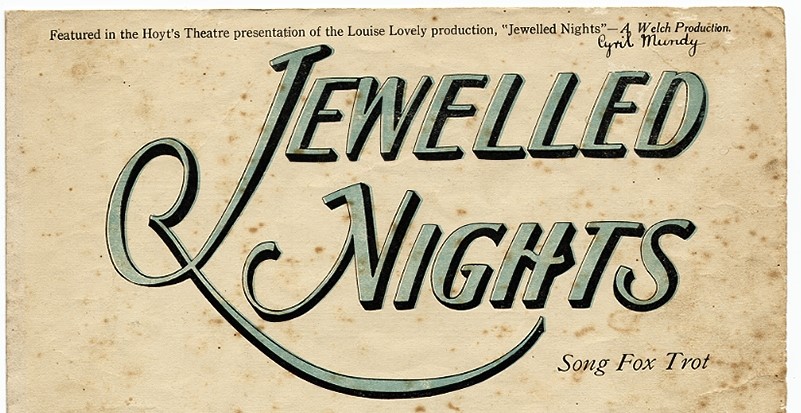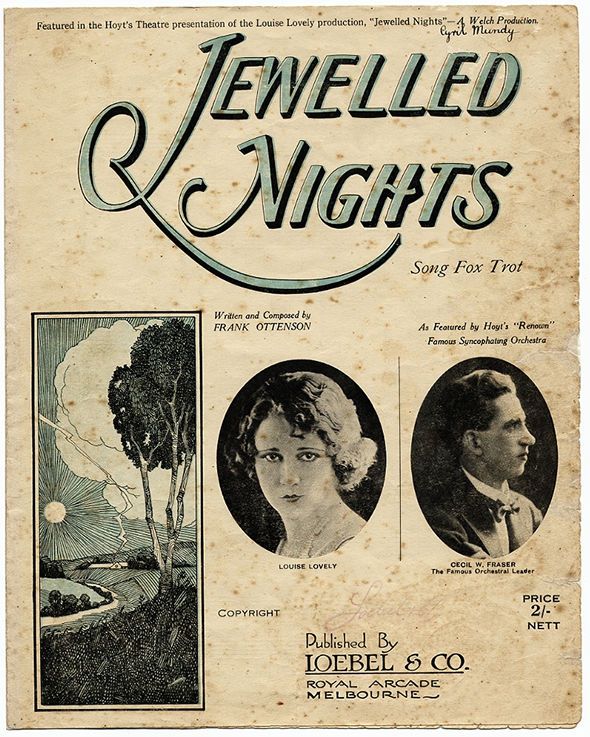Jewelled Nights: The Surprising Story of Two Tasmanian Women and their Lost Silent Film

Almost a century ago, two Tasmanian women wrote and produced a lost classic of Australian cinema. Set in the osmiridium mining fields of Tasmania’s Western Wilderness, Jewelled Nights was one of the first productions of its kind, created by the novelist Marie Bjelke Petersen and the silent film actress Louise Lovely in 1924.
Marie Bjelke Petersen wrote nine novels, many of which were set in the Tasmanian bush. Jewelled Nights (published in 1923) featured a runaway bride who sought her fortune in the osmiridium fields in Tasmania’s West, where miners panned and dug the precious metal that tipped gold fountain pens around the world. Petersen’s novel was brought to the silver screen by the Australian silent film star, Louise Lovely. Born Nellie Louise Carbasse in New South Wales in 1896, she went to Hollywood in 1914, where she became a leading lady. The two women met in Hobart in 1924 when Lovely was on tour with her husband, Wilton Welch. Taken with Petersen’s tale of romance, mining, and cross-dressing, Lovely wrote the screenplay, directed, produced, and starred in the film. Petersen’s account of the filming (together with some other manuscripts) are in the Tasmanian Archives and Heritage Office.

The ground-breaking film was shot on location at the osmiridium mining fields at Flea Flat on 19-Mile Creek, amidst unforgiving terrain and terrific challenges. It was hugely popular across Australia when it was released in 1926, from Melbourne and Sydney to the then-bustling town of Waratah. Audiences came in their thousands, and the film was hailed as a ‘splendid Australian production‘.
Despite its popularity, the film wasn’t much of a financial success for Lovely or for Petersen – it lost £3000, and there were no international sales. The film itself has now been lost, but a 2-minute excerpt has survived, and it’s considered to be a lost classic of Australian cinema.
The film might have vanished, but you can still play the soundtrack! TAHO has one of the few copies of the sheet music for the “Jewelled Nights Song Fox Trot“. Since this blog was originally written in March of 2018, the National Film and Sound Archive (NFSA) in Canberra has acquired two letters from Louise Lovely to one of her devoted fans, together with one of the costumes she wore in the film. And as one of our readers kindly pointed out on the original blog, “Belinda Holloway and family have loaned Louise Lovely’s travelling trunk to the TMAG,” and it periodically features in school holiday programs, exhibition talks and tours.
As for Louise Lovely and Marie Petersen, both ultimately ended up in Hobart. Lovely returned to Tasmania with her second husband, Burt Cowan. They lived in Lower Sandy Bay and she managed a sweet shop next to the Prince of Wales cinema, which Burt managed. Marie Petersen died in Lindisfarne in 1969.
Further Reading:
Nic Haygarth, On the Ossie. Hobart, Forty South Publishing, 2017.
To hear an ABC radio interview about Lousie Lovely’s house in Lower Sandy Bay, go here:
http://www.abc.net.au/radio/hobart/programs/statewideweekends/lovely-final/8867522



I have a couple of photos, 1 of the cast and crew and 1 during filming plus a photocopy of what could have been a press release if they are of interest to anyone.
Hi John, thank you for your comment. If you are interested in donating items to our collection, please complete our online collection offers form, available here: https://libraries.tas.gov.au/about-us/our-collections/tasmanian-heritage-collections/add-to-our-tasmanian-heritage-collections/collection-offers/, and a staff member will contact you directly. Many thanks,
Hi Anna,
Do you know if the cinematographer (not stills) was Tasman Higgins?
There is further footage of Jewelled Nights in the SBS documentary The Colour of Australia. It includes a racecourse scene. I’m guessing that it was a Tasmanian racecourse, given the other locations. Does anyone know which racecourse it might have been?
Hi Wayne, from the looks of this image at IMDB, it may have been Flemington Racecourse in Melbourne.
https://www.imdb.com/title/tt0190491/mediaviewer/rm3402265857/?ref_=ext_shr_lnk
John H Robinson was the stills photographer for the “Jewelled Nights” silent film .
See his photos in the John H Robinson Photos on Face book group.
Alison Alexander’s biography of Marie Bjelke Peterson, published in 1994, was launched just around the corner from the State Library, in the Playhouse. The surviving fragments of “Jewelled nights” were screened, and I sang the theme song of the film.
Thank you Tony, for this amazing note! We’ll have to have a search and see if the book launch and your performance were taped!
Belind Holloway and family have loaned Louise Lovely’s travelling trunk to the TMAG. Worth looking at.
Thanks very much for that information, Karolina!